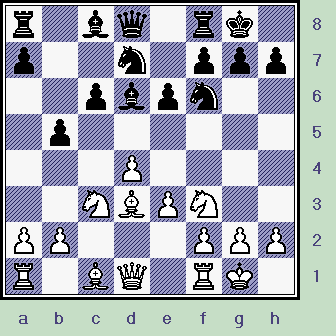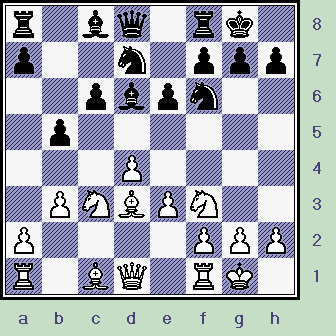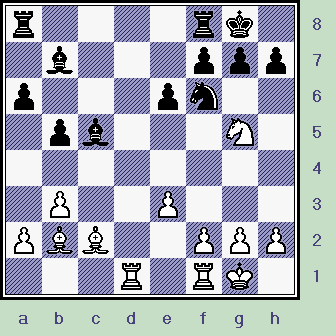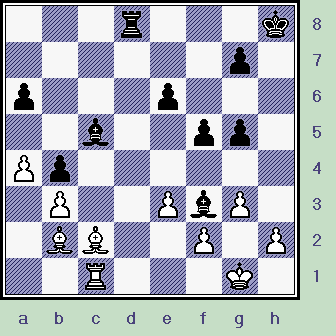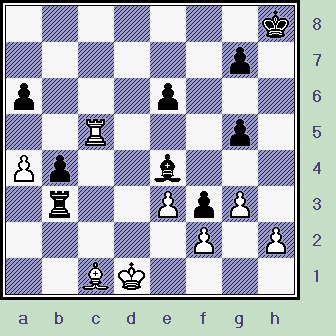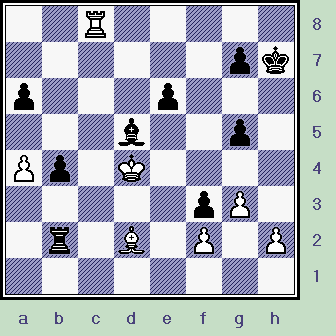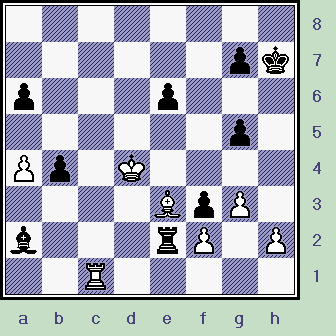GM Magnus Carlsen (2690) -
GM Viswanathan Anand (2779)
|
|
|
r1bq1rk1/p2n1ppp/2pbpn2/1p6/3P4/2NBPN2/PP3PPP/R1BQ1RK1 w
10.b3!?, {Diagram
below.}
A very simple move, and in truth, not a terribly ambitious one.
|
|
r1bq1rk1/p2n1ppp/2pbpn2/1p6/3P4/1PNBPN2/P4PPP/R1BQ1RK1 b
e4, Qc2 and even Bd2 are all moves that have seen more use (and success) than 10.b3, at least according to the 2006 Fritz Power Book. (Perhaps young Carlsen was thinking that this would be a good move to get both players out of their 'book' and throw both parties on their own resources here.) I only found 18 games in my database ... when searching it by the current position ... that we now have on the chess board.
[ A little sharper was:
(>/=) 10.Qc2
Bb7; 11.a3 a6; 12.b4 a5; 13.Rb1 axb4;
14.axb4 Qe7; 15.e4, "+/="
when White has the center.
GM Garry Kasparov (2815) - GM Vladimir Kramnik (2780) /
Kosmos Blitz (5') Match
Moscow,
RUS; (R22) / 1998.
{White won a sharp game, 1-0 in just 37 total moves.}
]
10...Bb7; 11.Bb2 a6; 12.Ne4,
I think White played this ... in an effort to prevent Black from getting in the ...c6-c5 pawn break.
[ The machine prefers 12.Qc2, here for White. ]
The next few moves look forced.
12...Nxe4; 13.Bxe4 Nf6; (TN?)
This could be a new move here, the Fritz "Power-Book" only gives 13...f5 here for Black.
[ After the moves:
13...f5; ('!?')
14.Bc2 c5; 15.dxc5 Nxc5; 16.b4
Ne4; 17.Bb3 Qe7; 18.a3, "~"
White has (maybe) a tiny edge ... and went on to win in 59 moves.
K. Murugan
(2390) - K. Gunasekaran
(2265); /
ICT, 1st Chennai WinTV Open
/ (R 10);
29,01,2004. (59 moves.) {However, Black's play in this contest could
be greatly improved upon.} ]
14.Bc2 c5; 15.dxc5 Bxc5;
We have (now) reached a symmetrical position, White has a slight advantage ... or at least, this is what Fritz "thinks" in this position. (I am inclined to agree ... mostly on positional grounds. White has completed his development, and has a Rook on a nice central file.)
16.Ng5! Qxd1;
{Box?}
This might be forced (for Black).
[ Instead, after the moves:
</=
16...h6?!; 17.Bxf6 gxf6;
18.Nh7 Qxd1; 19.Raxd1 Rfd8;
20.Nxf6+, "+/"
and White has won a clear Pawn, and Black's King-side is in tatters.
]
(Now - when I first studied this game at chess club - I thought that taking with the KR
...
was the simplest and the best.)
17.Raxd1,
"+/=" {Diagram
below.}
This is the current situation that we have on the chess board.
|
|
r4rk1/1b3ppp/p3pn2/1pb3N1/8/1P2P3/PBB2PPP/3R1RK1 b
When I first saw this position, I did not see how Black could avoid loss of material on his Kingside.
[ Better was: >/= 17.Rfxd1!, "+/=" - GM Mihail Marin. (From his report on the CB website.) ]
17...Kh8!;
(Maybe - '!!')
I was completely taken aback by this move, I did not understand it at all.
(Not at first ... see the variations after White's next move.)
18.g3!?,
This looks reasonable, yet White's Kingside is {now} clearly somewhat compromised.
[ White cannot (now) win material, as the following variation shows:
</=
18.Bxf6 gxf6; 19.Nxh7?! Rg8;
20.g3 Kg7; 21.Rd7 Bc6;
22.Rc7 Rac8;
23.Rxc8 Rxc8;
24.g4 f5!; 25.Ng5 Kf6;
26.Nh7+, A desperate try.
( Or if >/= 26.Nh3, then simply 26...fxg4;
"/+" and Black is clearly better,
(Fritz considers this position to already be winning for Black!). )
26...Kg6;
27.gxf5+ Kxh7; 28.fxe6+ Kg7; 29.exf7 Kxf7;
"/+"
and although White has three Pawns for the piece, he is probably losing in
this position. ("-/+")
*************************************
White's best line might have possibly been:
(>/=)
18.Bxf6 gxf6; 19.Ne4 Bxe4;
20.Bxe4 Rad8; "~"
(Close to "=")
when a draw is the likely outcome. ]
18...h6!;
19.Bxf6 hxg5!;
A nice "in-between" move. (Maybe this is what Carlsen had managed to overlook?)
20.Bb2,
This might be forced - certainly the g-Pawn is off limits for White.
[ Instead, after the moves:
</= 20.Bxg5? f6;
21.Bf4 e5;
22.Rd7 Bf3;
23.Rc7 Rfc8;
24.Rxc8+ Rxc8; 25.Bf5 Rd8;
26.Rc1 exf4; "-/+"
White has lost material. (The Black Bishop on c5 is off limits, due to
the threat of ...Rd1 mate.) ]
Now 20...g4 is the machine's first choice, however, Anand chooses a slightly different route.
20...Rac8;
21.Rc1!? Rfd8;
22.Rfd1 Bf3; 23.Rxd8+ Rxd8;
24.a3 b4; 25.a4,
Carlsen strives to keep the position closed, but I do not know if this was the best defense for Black.
[ Perhaps the continuation of:
25.axb4 Bxb4; 26.h3 a5;
"=/+"
was a little better than the game? (This is not 100% certain, and
could be open for debate ... depending on which analysis engine
you choose.) ]
25...f5;
("/+") {Diagram
below.}
White's opening has been a dismal failure, Black is already clearly better here.
|
|
3r3k/6p1/p3p3/2b2pp1/Pp6/1P2PbP1/1BB2P1P/2R3K1 w
This would be a good place for the aspiring student to study the board to see if he (or she) could ascertain why Black is better in this particular position.
26.Kf1 f4!?;
hmmmm
Black goes for vigorous play.
(Fritz prefers >/= 26...g4!; "/+" here, this would have guaranteed Black a solid advantage.)
27.Be4?!,
White misses the best defense.
(Carlsen had consumed a lot of time in the opening, and was already having to hurry his moves.)
[ Carlsen should have played:
>/=
27.gxf4! gxf4; 28.exf4 Rd2;
29.Bg6 Rxf2+; 30.Ke1 Re2+; 31.Kf1,
"~" (Maybe "=")
when Black might have to grab the perpetual check, as the line of 31...RxB/b2?; 32.RxB/c5,
looks dangerous for the second player. (In this case, Black would be a Pawn down, and his
King would be nailed down to the first rank.)
]
27...Bxe4;
28.Rxc5 Rd1+;
29.Ke2 Rb1; 30.Bc1 f3+;
31.Kd1 Rxb3; {Diagram
below.}
Carlsen has found some drawing chances in this endgame with "Bishops of opposite colors," however, he is unable to hold this position. (Black's passed b-Pawn gives Anand all of the high cards in this hand.)
|
|
7k/6p1/p3p3/2R3p1/Pp2b3/1r2PpP1/5P1P/2BK4 w
This would be a good place to stop and try to evaluate the position.
32.Rc4 Bd3;
33.Rc8+ Kh7;
34.e4,
White is willing to sacrifice another Pawn ... to try and get his QB out of its "virtual tomb" here.
[ Or 34.Rc6!? e5; "/+" but Black is still better here. ]
34...Rb1;
35.Kd2!? Bxe4;
36.Ke3 Bd5; 37.Bd2 Rb3+!;
38.Kd4 Rb2; {Diagram
below.}
A critical position has been reached here.
|
|
2R5/6pk/p3p3/3b2p1/Pp1K4/5pP1/1r1B1P1P/8 w
39.Be3?!,
This allows a quick decision. ('?')
[ Defense ... with 39.Kd3, was not fun or attractive, but was probably White's best choice.
Yet, this would not have saved White, as the following variation clearly shows:
39.Kd3 g4;
40.Rc7 Kg6;
41.Ra7 e5!; 42.Rxa6+ Kf5;
43.a5?! e4+; 44.Ke3 Ke5;
45.Rb6 Rb3+;
46.Bc3+ Rxc3+;
47.Kd2 e3+!; 48.fxe3 f2; "-/+"
and Black wins handily.
(I do not claim that this variation is conclusive, nor an example of best play for both sides ...
just a good {possible} illustration of the various themes and tactics, and how Black might
have been able to win the game after the superior defense of 39...Kd3.)
]
39...Re2;
"!?" (Maybe - '!' or '!!)
My first instinct was to play 39...Ra2, (to go after White's last Q-side Pawn); or play 39...Kg6. However, a computer analysis reveals that Anand's move is very strong ... and quite possibly the best for Black in this position.
40.Rc1 Ba2!; "-/+" White Resigns. {Diagram below.}
|
|
8/6pk/p3p3/6p1/Pp1K4/4BpP1/b3rP1P/2R5 w
The Black b-Pawn is free to waltz in ... and there is little that White can do to stop it.
An enjoyable game, and one that clearly shows Anand's wizardry ... in all phases of the game.
Copyright (c) A.J. Goldsby, 2007. All rights reserved.
